I'm after some advice regarding better geometry for shop made cutters. My questions are in the end. I wasn't sure if this should go into weapons or shop made tooling as I make such cutters for various things and this is not the first time I encountered the problem. This particular use involved a gun so I decided to put it in this forum.
First some background info.
I had a need to cut new crowns as well as square muzzle face on a double rifle barrels that are too wide to be mounted in the spindle through hole of my lathe. So I decided to make piloted reamer cutters for the purpose. Both barrels bore diameters were within half a thou of one another so one pilot should be enough. I made my pilot few tenths below the diameter of the smaller barrel resulting in a pretty tight slip fit in the tight and an easy slip fit in the looser barrel.
I made both reamers from a 22mm rod of water hardening tool steel (1.2210 here in EU, silver steel in US). I rough turned the blanks to within 1mm (40 thou), of the final diameter on my large lathe for speed and I transferred blanks to my mini lathe to finish turn them between centers. Here is a picture of turning the 45 degree cutter blank.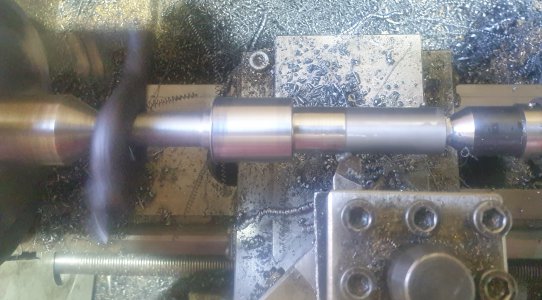
The pilot is on the right. I turned it half a thou (0.005mm) oversize and finished it with sandpaper.
Here is the finished 45 degree blank.
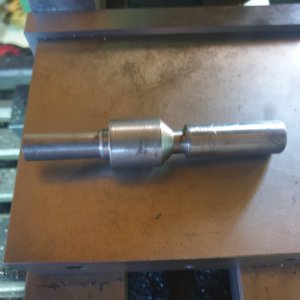
Then teeth were cut using a square er40 collet holder on a mill. Unfortunately I didn't take pictures if that process.
Here is a picture after heat treatment.
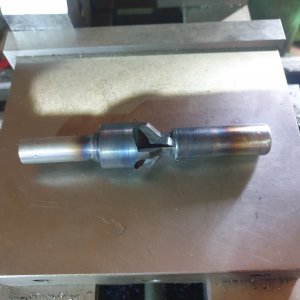
Both cutters had the inside of their teeth stoned by hand and the relief angles ground on a tiny tool and cutter grinder.
Here they are side by side.
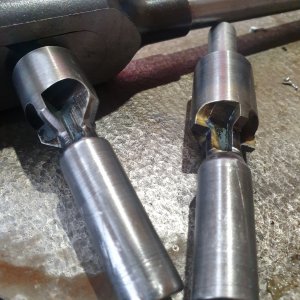
And another picture showing 90 degree cutter tooth geometry (simple 11 degree relief, teeth cut 10 thou in front of the centre). Yes 45 degree cutter is cutting left and the 90 degree right... It just happened, but they both work fine.
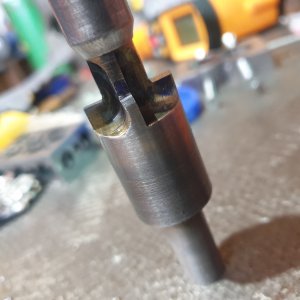
The yellowish color is due to post heat treatment cleaning with a brass wire brush.
So now to the point of my post The cutters performed well by hand being turned with a large threading handle.
The cutters performed well by hand being turned with a large threading handle.
However, specially regarding the 90 degree cutter I had to turn it very slowly and carefully or it would chatter and leave marks on the face being cut I'll show on the next photo. Teeth were ground lengthwise with 2 tenths precision. There is no way this chatter is caused by uneven teeth. I'm thinking this is a chip evacuation issue. This is further supported by an experiment that when I was blowing compressed air into the cutting area it seemed to chatter less.
Here the right barrel shows ugly chatter marks.
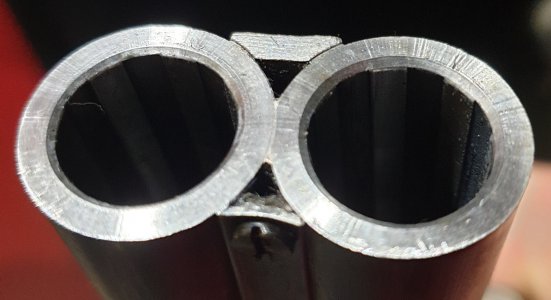
No such chatter occurred with the 45 degree cutter. I managed to clean up those marks by feeding it very slowly, 1mm per second sfm slow...
So my question is, could I improve the geometry somehow so the cutter cuts without chatter?
First some background info.
I had a need to cut new crowns as well as square muzzle face on a double rifle barrels that are too wide to be mounted in the spindle through hole of my lathe. So I decided to make piloted reamer cutters for the purpose. Both barrels bore diameters were within half a thou of one another so one pilot should be enough. I made my pilot few tenths below the diameter of the smaller barrel resulting in a pretty tight slip fit in the tight and an easy slip fit in the looser barrel.
I made both reamers from a 22mm rod of water hardening tool steel (1.2210 here in EU, silver steel in US). I rough turned the blanks to within 1mm (40 thou), of the final diameter on my large lathe for speed and I transferred blanks to my mini lathe to finish turn them between centers. Here is a picture of turning the 45 degree cutter blank.

The pilot is on the right. I turned it half a thou (0.005mm) oversize and finished it with sandpaper.
Here is the finished 45 degree blank.

Then teeth were cut using a square er40 collet holder on a mill. Unfortunately I didn't take pictures if that process.
Here is a picture after heat treatment.

Both cutters had the inside of their teeth stoned by hand and the relief angles ground on a tiny tool and cutter grinder.
Here they are side by side.

And another picture showing 90 degree cutter tooth geometry (simple 11 degree relief, teeth cut 10 thou in front of the centre). Yes 45 degree cutter is cutting left and the 90 degree right... It just happened, but they both work fine.

The yellowish color is due to post heat treatment cleaning with a brass wire brush.
So now to the point of my post
However, specially regarding the 90 degree cutter I had to turn it very slowly and carefully or it would chatter and leave marks on the face being cut I'll show on the next photo. Teeth were ground lengthwise with 2 tenths precision. There is no way this chatter is caused by uneven teeth. I'm thinking this is a chip evacuation issue. This is further supported by an experiment that when I was blowing compressed air into the cutting area it seemed to chatter less.
Here the right barrel shows ugly chatter marks.

No such chatter occurred with the 45 degree cutter. I managed to clean up those marks by feeding it very slowly, 1mm per second sfm slow...
So my question is, could I improve the geometry somehow so the cutter cuts without chatter?

